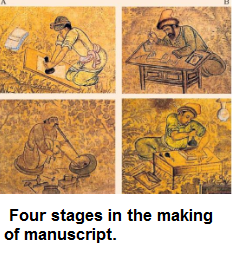Delhi Sultanate

Delhi Sultanate
Delhi Sultanate, or Muslim sultanate in north India from the 13th to the 16th century. Its creation owed much to the campaigns of Mu'izzal-Din Muhammad ibn sam (Muḥammad of GhÅ«r; brother of Sultan GhiyÄth al-DÄ«n of GhÅ«r) and his lieutenant Qulbal- Din Aibak between 1175 and 1206 and particularly to victories at the battles of Taraori in 1192 and Chandawar in 1194.
The Delhi Sultans built many cities in the area that we now know as Delhi. Muslim rule in India was established by Mohammad Ghori in the 12th century CE. In this, Ghori was helped by his general, Qutbuddin Aibak. Ghori appointed Aibak as the viceroy of his Indian conquests.

Finding Out about the Delhi Sultans: Although inscriptions, coins and architecture provide a lot of information, especially valuable are “histories”, Tarikh (singular)/Tawarikh (plural). Written in Persian, the language of administration under the Delhi sultans.

The power of the Delhi sultanate in north India was shattered by the invasion (1398–99) of Turkic conqueror Timur (Tamerlane), who sacked Delhi itself. Under the Sayyid Dynasty (c. 1414–51). Thesultanate was reduced to a country power continually contending on an equal footing with other petty Muslim and Hindu principalities.
Under the Lodi (Afghan) Dynasty (1451–1526), however, with large-scale immigration from Afghanistan, the Delhi sultanate partly recovered its hegemony until the Mughal leader Babur destroyed it at the First Battle of Panipat on April 21, 1526.
After 15 years of Mughal rule, the Afghan Sher shah Suri reestablished the sultanate in Delhi, which fell again in 1555 to BÄbur’s son and successor, Humayun who died in January 1556. At the Second Battle of Panipat (November 5, 1556), HumÄyÅ«n’s son Akbar definitively defeated the Hindu general Hemu, and the sultanate became submerged in the Mughal Empire.
The Delhi Sultanate during the 15th and 16th century
Students / Parents Reviews [20]
It was good as the experience because as we had come here we had been improved in a such envirnment created here.Extra is taught which is beneficial for future.

Eshan Arora
8thBeing a parent, I saw my daughter improvement in her studies by seeing a good result in all day to day compititive exam TMO, NSO, IEO etc and as well as studies. I have got a fruitful result from my daughter.

Prisha Gupta
8thThird consective year,my ward is in Abhyas with nice experience of admin and transport support.Educational standard of the institute recumbent at satisfactory level. One thing would live to bring in notice that last year study books was distributed after half of the session was over,though study ...

Ayan Ghosh
8thMy experience with Abhyas Academy has been very good. When I was not in Abhyas whenever teacher ask questions I could not speak it confidently but when I came in Abhyas, my speaking skills developed and now I am the first one to give the answer of teachers question.

Upmanyu Sharma
7thAbhyas is an institute of high repute. Yogansh has taken admission last year. It creates abilities in child to prepare for competitive exams. Students are motivated by living prizes on basis of performance in Abhyas exams. He is satisfied with institute.

Yogansh Nyasi
7thMy experience was very good with Abhyas academy. I am studying here from 6th class and I am satisfied by its results in my life. I improved a lot here ahead of school syllabus.

Ayan Ghosh
8thThe experience was nice. I studied here for three years and saw a tremendous change in myself. I started liking subjects like English and SST which earlier I ran from. Extra knowledge gave me confidence to overcome competitive exams. One of the best institutes for secondary education.

Aman Kumar Shrivastava
10thA marvelous experience with Abhyas. I am glad to share that my ward has achieved more than enough at the Ambala ABHYAS centre. Years have passed on and more and more he has gained. May the centre flourish and develop day by day by the grace of God.

Archit Segal
7thWe started with lot of hope that Abhyas will help in better understnding of complex topics of highers classes. we are not disappointed with the progress our child has made after attending Abhyas. Though need to mention that we expected a lot more. On a scale of 1-10, we would give may be 7.

Manya
8thAbhyas Methodology is very good. It is based on according to student and each child manages accordingly to its properly. Methodology has improved the abilities of students to shine them in future.

Manish Kumar
10thAbhyas institute is one of the best coaching institute in the vicinity of Ambala cantt.The institute provides good and quality education to the students.The teachers are well experienced and are very helpful in solving the problems. The major advantages of the institute is extra classes for weak...

Shreya Shrivastava
8thUsually we see institutes offering objective based learning which usually causes a lag behind in subjective examinations which is the pattern followed by schools. I think it is really a work of planning to make us students grab the advantages of modes of examination, Objective Subjective and Onli...

Anika Saxena
8thIt has a great methodology. Students here can get analysis to their test quickly.We can learn easily through PPTs and the testing methods are good. We know that where we have to practice

Barkha Arora
10thMy experience with Abhyas academy is very good. I did not think that my every subject coming here will be so strong. The main thing is that the online tests had made me learn here more things.

Hiya Gupta
8thAbhyas academy is great place to learn. I have learnt a lot here they have finished my fear of not answering.It has created a habit of self studying in me.The teachers here are very supportive and helpful. Earlier my maths and science was good but now it has been much better than before.

Barkha Arora
10thAbhyas is good institution and a innovative institute also. It is a good platform of beginners.Due to Abhyas,he has got knoweledge about reasoning and confidence.My son has improved his vocabulary because of Abhyas.Teacher have very friendly atmosphere also.

Manish Kumar
10thWhen I have not joined Abhyas Academy, my skills of solving maths problems were not clear. But, after joining it, my skills have been developed and my concepts of science and SST are very well. I also came to know about other subjects such as vedic maths and reasoning.

Sharandeep Singh
7thIt was a good experience with Abhyas Academy. I even faced problems in starting but slowly and steadily overcomed. Especially reasoning classes helped me a lot.

Cheshta
10thOne of the best institutes to develope a child interest in studies.Provides SST and English knowledge also unlike other institutes. Teachers are co operative and friendly online tests andPPT develope practical knowledge also.

Aman Kumar Shrivastava
10thAbhyas institute is one of the best coaching institute in the vicinity of Ambala Cantt area. The teachers of the institute are well experienced and very helpful in solving the problems of the students.The good thing of the institute is that it is providing extra classes for the students who are w...








